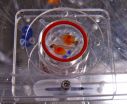Wind effect following team car can help time trial rider win Tour prologue
Eindhoven University of Technology shows aerodynamic effects can save tens of seconds in cycling time trials
2015-06-29
(Press-News.org) Will next Saturday's Tour de France prologue in Utrecht get the winner it deserves? New aerodynamic research at Eindhoven University of Technology (TU/e) shows that riders in a time trial can save vital seconds by riding closer to the following team car. Over a short distance like the prologue of the Tour de France, that can save as much as 6 seconds: enough to make the difference between winning and losing. On longer time trials and events like world championships, the effect can even add up to tens of seconds. Which is why aerodynamics professor Bert Blocken is advising the international cycling union UCI to change the rules and increase the minimum gap between riders and their team cars. "The present rules could lead to unfair advantage."
It's well known that cyclists save wind resistance by riding behind a car. But the fact that wind losses also drop when you're in front of a car is a new finding. In simple terms, a car reduces the pressure drop behind you - which slows you down - while you're riding. And the smaller the gap between rider and car, the bigger the effect of the team car behind. It was already known that this also applies to pairs of riders: Rider at the front gets speed benefit from follower.
Wind tunnel tests and computer simulation
TU/e professor and cycling enthusiast Bert Blocken uses his aerodynamics knowledge to calculate the effects that following team cars have in today's cycling. Those cars should officially hold a distance of at least 10 meter, even though in practice they often maintain a shorter gap. Blocken has carried out computer simulations and wind tunnel measurements using models of a time trial rider and team car. He was surprised by the results: the effect proved to be greater than expected.
Decisive time savings
In the case of the prologue of the Tour de France next Saturday in Utrecht, riders in this time trial can save around 6 seconds if the team car maintains a gap of 5 meters, instead of the 10 meters laid down by the regulations. That difference can be decisive: time trials have often been won or lost by smaller margins. In a typical 50 kilometer time trial, the time difference can add up to 20 seconds or more. And if the gap between the rider and the team car is reduced to just 3 meters, it can even reach a full minute. Strictly speaking that may be against the rules, but TV pictures show that in practice that team cars don't always observe the 10 meters laid down by the regulations.
Gap of at least 30 meters
Even though the effect may in practice be less due to changing conditions, Blocken hopes that his findings will convince the UCI, the international cycling union, to change the rules for following team cars. "Now there may be an unfair advantage. That 10 meter gap was originally laid down for safety reasons, when this effect wasn't known. To remove any doubts the UCI should now increase the minimum gap to 30 meters, because at that distance the effect of team cars is negligible. And of course that should be strictly enforced, to make sure that everyone sticks to it."
INFORMATION:
[Attachments] See images for this press release:


ELSE PRESS RELEASES FROM THIS DATE:
2015-06-29
US researchers extol the virtues of high-altitude balloons for science education in a research paper published in the International Journal of Learning Technology. According to Jeremy Straub of the University of North Dakota in Grand Forks, "High-altitude balloons can carry student and scientific payloads to the boundaries of space."
This, he suggests, gives students the opportunity to carry out experiments in a cold, near-vacuum, higher-radiation environment at such very high altitudes. "In the process, students experience the awe of space exploration as, through their ...
2015-06-29
Nyon, Switzerland - June 29, 2015 While there is good understanding of how bone mass, and more recently bone architecture, affects fracture risk, far less is known about the material properties of bone, or how these can impart resilience or fragility to the skeleton. This is changing thanks to the development of new state-of-the-art imaging and other technologies which now allow researchers to gain new insights into the different material properties of bone and their role in bone fragility.
Bringing together eight invited contributions by the field's leading experts, ...
2015-06-29
CHICAGO (June 29, 2015): A scoring system that can identify periods of high activity and increased trauma patient deaths in hospital emergency rooms may help hospitals better prepare for surges in trauma patient volume that come with catastrophic events like the Boston Marathon bombing (April 2013) or disasters like the Amtrak train crash (May 2015) in Philadelphia.
Trauma surgeon Peter C. Jenkins, MD, MSc, and a team of investigators from Indiana University and multiple centers developed the scoring system, called the Trauma Surge Index (TSI). They reported their observations ...
2015-06-29
WASHINGTON, June 29, 2015 -- If you're firing up the barbecue this week for an Independence Day cookout, you don't want to miss this week's Reactions video. We've got chemistry knowledge that will impress your guests like, "Why is red meat red?" You'll also learn about the amazing Maillard reaction that turns that red meat into a delicious grilled brown. We also settle, once and for all, the age-old debate of gas vs. charcoal. It's all in our latest video: https://youtu.be/RqUEh-B-U-k.
Subscribe to the series at http://bit.ly/ACSReactions, and follow us on Twitter @ACSreactions ...
2015-06-29
HOUSTON, June 29 -- Many parents have heard the night-time cry of "my ear hurts." For some children, this might happen frequently beginning in infancy and even persist into adulthood. An international consortium led by those at Baylor College of Medicine may have taken the first step on the road to understanding why only some people get frequent painful or chronic middle ear infections. The culprit may be rare genetic variants in a gene called A2ML1.
A report on their work appears online in the journal Nature Genetics.
In studies led by Dr. Regie Lyn P. Santos-Cortez, ...
2015-06-29
New research released today in Nature Neuroscience reveals for the first time that pain is processed in male and female mice using different cells. These findings have far-reaching implications for our basic understanding of pain, how we develop the next generation of medications for chronic pain--which is by far the most prevalent human health condition--and the way we execute basic biomedical research using mice.
"Research has demonstrated that men and women have different sensitivity to pain and that more women suffer from chronic pain than men, but the assumption ...
2015-06-29
Neighborhood resources to support greater physical activity and, to a lesser extent, healthy diets appear to be associated with a lower incidence of type 2 diabetes, although the results vary by the method of measurement used, according to an article published online by JAMA Internal Medicine.
Type 2 diabetes mellitus (T2DM) is an important cause of death and disability worldwide. Prevention of T2DM has focused largely on behavioral modification. However, the extent to which behavioral modifications will succeed in unsupportive environments remains unknown.
Researcher ...
2015-06-29
More than a third of children and teens 17 and younger experienced a physical assault in the last year, primarily at the hands of siblings and peers, according to an article published online by JAMA Pediatrics.
Violence against children is a national and international public health and public policy issue. The U.S. Department of Justice and Centers for Disease Control and Prevention initiated in 2008 the National Survey of Children's Exposure to Violence (NatSCEV) to provide ongoing estimates of a wide range of violence against youth. Assessments have occurred in three-year ...
2015-06-29
An 'exhausted' army of immune cells may not be able to fight off infection, but if its soldiers fight too hard they risk damaging the very body they are meant to be protecting, suggests new research from the University of Cambridge.
Inside our bodies are billions of immune cells known as T cells that protect us from infection, fighting off attacks from invading bacteria and viruses, and also from cancer. One teaspoon full of blood alone is believed to have around 5 million T cells. But these cells can also do harm, mistaking our own cells for invaders and attacking them, ...
2015-06-29
Pink salmon that begin life in freshwater with high concentrations of carbon dioxide, which causes acidification, are smaller and may be less likely to survive, according to a new study from UBC.
The risks of ocean acidification on marine species have been studied extensively but the impact of freshwater acidification is not well understood. The study is one of the first to examine how rising carbon dioxide levels caused by climate change can impact freshwater fish.
"Most of the work on acidification has been in the ocean, yet 40 per cent of all fish are freshwater. ...
LAST 30 PRESS RELEASES:
[Press-News.org] Wind effect following team car can help time trial rider win Tour prologue
Eindhoven University of Technology shows aerodynamic effects can save tens of seconds in cycling time trials



